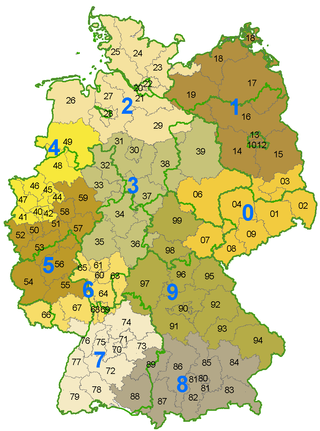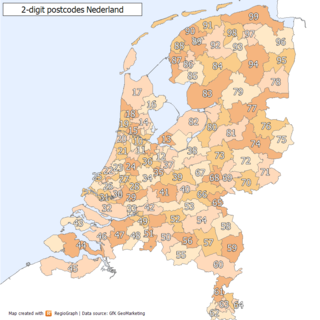Related Research Articles

A postal code is a series of letters or digits or both, sometimes including spaces or punctuation, included in a postal address for the purpose of sorting mail.

A ZIP Code is a system of postal codes used by the United States Postal Service (USPS). The term ZIP was chosen to suggest that the mail travels more efficiently and quickly when senders use the code in the postal address.

Postal codes used in the United Kingdom, British Overseas Territories and Crown dependencies are known as postcodes. They are alphanumeric and were adopted nationally between 11 October 1959 and 1974, having been devised by the General Post Office. A full postcode is known as a "postcode unit" and designates an area with several addresses or a single major delivery point.

A Canadian postal code is a six-character string that forms part of a postal address in Canada. Like British, Irish and Dutch postcodes, Canada's postal codes are alphanumeric. They are in the format A1A 1A1, where A is a letter and 1 is a digit, with a space separating the third and fourth characters. As of October 2019, there were 876,445 postal codes using Forward Sortation Areas from A0A in Newfoundland to Y1A in Yukon.
A Postal Index Number refers to a six-digit code in the Indian postal code system used by India Post. On 15 August 2022, the PIN system celebrated its 50th anniversary.
Postal codes were introduced in South Africa on 8 October 1973, with the introduction of automated sorting.
Spanish postal codes were introduced on 1 July 1984, when the Sociedad Estatal de Correos y Telégrafos introduced automated mail sorting. They consist of five numerical digits, where the first two digits, ranging 01 to 52, correspond either to one of the 50 provinces of Spain or to one of the two autonomous cities on the African coast.

In the Philippines, a ZIP code is used by the Philippine Postal Corporation (PhlPost) to simplify the distribution of mail. While its function similar with the ZIP Codes used in the United States, its form and usage are quite different. Its use is not mandatory but highly recommended by the PhlPost. A ZIP code is composed of a four-digit number representing a locality. Usually, more than one code is issued for areas within Metro Manila, and a single code for each municipality and city in provincial areas, with some rare exceptions such as Dasmariñas in Cavite, which has three ZIP codes, Los Baños in Laguna, which has two ZIP codes, and Angeles City, which has two ZIP codes.
Four-digit postal codes were introduced in Romania in 1974. Beginning with 1 May 2003, postal codes have six digits, and represent addresses to the street level in major cities. The digits represent the postal area; the county; the city/commune; the last three, depending on the size of the city/commune, represent the commune/city, the street, or the house/building.
ISO 3166-2:NI is the entry for Nicaragua in ISO 3166-2, part of the ISO 3166 standard published by the International Organization for Standardization (ISO), which defines codes for the names of the principal subdivisions of all countries coded in ISO 3166-1.

The following outline is provided as an overview of and topical guide to Nicaragua:

The Nicaraguan Postal Service, is a postal service that is decentralized from the Nicaraguan government, but offers a public service to the people.

Postal codes in Hungary are four digit numeric. The first digit is for the postal region, as listed below :

Germany introduced postal codes on 25 July 1941, in the form of a two-digit system that was applied initially for the parcel service and later for all mail deliveries. This system was replaced in 1962 in West Germany by a four-digit system; three years later East Germany followed with its own four-digit system. Whereas the Federal Republic introduced a system with space left for the East German postal system after a possible reunification, such as by omitting all codes starting with '1' and '9', the German Democratic Republic had a system that used all codes starting from '1' to '9' just for East Germany.

Russian Post has a system of postal codes based on the federal subject a place is located in. Each postal code consists of six digits with first three referring to the federal subject or the administrative division with special status. Some larger subjects have multiple three-digit prefixes. For instance, Moscow's postal codes fall in the range 101–129.

Postal codes in the Netherlands, known as postcodes, are alphanumeric, consisting of four digits followed by two uppercase letters. The letters 'F', 'I', 'O', 'Q', 'U' and 'Y' were originally not used for technical reasons, but almost all existing combinations are now used as these letters were allowed for new locations starting 2005. The letter combinations 'SS', 'SD' and 'SA' are not used because of their associations with the Nazi occupation of the Netherlands.

This is a survey of the postage stamps and postal history of Nicaragua.

India-Nicaragua relations are the bilateral relations between India and Nicaragua. Relations have been limited to Central American Integration System dialogue and visits by Nicaraguan Ministers to India. India maintains an honorary consul general in Nicaragua, concurrently accredited to the Indian embassy in Panama City and Nicaragua used to maintain an embassy in India. It was reduced to an honorary consulate general in New Delhi. Nicaragua supports India's candidatures for UN bodies and international organizations. This includes the International Maritime Organization, Universal Postal Union, ECOSOC committees, UN ECOSOC, UNESCO's ICH, ICPO-Interpol, and UNSC non-permanent membership.
